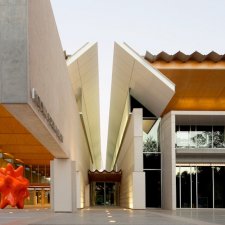- About us
- Support the Gallery
- Venue hire
- Publications
- Research library
- Organisation chart
- Employment
- Contact us
- Make a booking
- Onsite programs
- Online programs
- School visit information
- Learning resources
- Little Darlings
- Professional learning
Frank Hinder (1906–1992), painter, illustrator and printmaker, exerted a major influence on the development of modern art in Australia. He received his first lessons in art from his father, an amateur painter, before studying with Antonio Dattilo Rubbo at the Royal Art Society and at the East Sydney Technical College. Unlike most of his artist contemporaries, Hinder went to the United States for further study, training at the Art Institute of Chicago school in 1927–28 and studying commercial art at the New York School of Fine and Applied Art and the Master Institute of the Roerich Museum. He worked as a commercial artist in America and taught at an art school in Boston before returning to Australia with his wife, the New York-born sculptor Margel Harris, and their daughter, Enid, in 1934. In Sydney, Hinder and Margel became involved with artists Ralph Balson, Grace Crowley and Rah Fizelle, enlivening the 1930s art scene with modernist work based on his experience of cubism. Among his best known works are those inspired by the city’s underground railway system, such as Subway, Wynyard (1948). Hinder was a founding member of the Contemporary Art Society and in 1939 helped organise Australia’s first exhibition of abstract art, Exhibition 1. Hinder worked in the camouflage unit of the Royal Australian Engineers during World War II, devising methods of concealing large structures such as the petrol storage tanks in Newcastle and Port Kembla. After the war, he taught at the East Sydney Technical College and the Sydney Teachers’ College and also worked in theatre design and commercial art. Hinder’s abstract paintings and electric light sculptures attracted much critical acclaim and he assisted Margel in the completion of a number of public sculpture commissions in the 1950s and 60s. This self portrait is characteristic of Hinder’s work in its sharp-edged precision.
Gift of an anonymous donor 2007
© Enid Hawkins (nee Hinder)
Frank Hinder (age 43 in 1949)



On one level The Companion talks about the most famous and frontline Australians, but on another it tells us about ourselves.



Visit us, learn with us, support us or work with us! Here’s a range of information about planning your visit, our history and more!



We depend on your support to keep creating our programs, exhibitions, publications and building the amazing portrait collection!